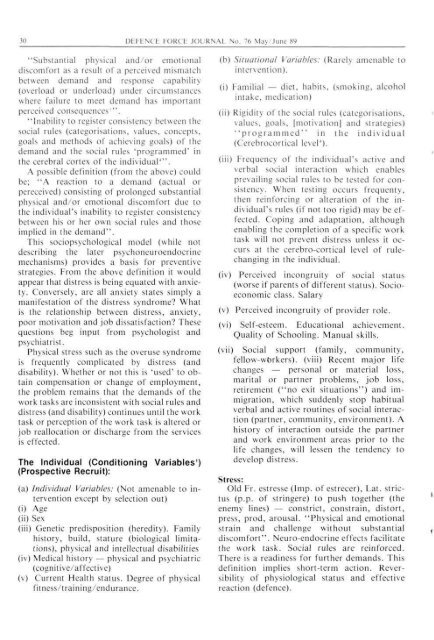ISSUE 76 : May/Jun - 1989 - Australian Defence Force Journal
ISSUE 76 : May/Jun - 1989 - Australian Defence Force Journal
ISSUE 76 : May/Jun - 1989 - Australian Defence Force Journal
- No tags were found...
You also want an ePaper? Increase the reach of your titles
YUMPU automatically turns print PDFs into web optimized ePapers that Google loves.
30 DEFENCE FORCE JOURNAL No. <strong>76</strong> <strong>May</strong>/<strong>Jun</strong>e 89"Substantial physical and/or emotionaldiscomfort as a result of a perceived mismatchbetween demand and response capability(overload or underload) under circumstanceswhere failure to meet demand has importantperceived consequences 1 "."Inability to register consistency between thesocial rules (categorisations, values, concepts,goals and methods of achieving goals) of thedemand and the social rules 'programmed' inthe cerebral cortex of the individual 4 ".A possible definition (from the above) couldbe; "A reaction to a demand (actual orpereceived) consisting ot prolonged substantialphysical and/or emotional discomfort due tothe individual's inability to register consistencybetween his or her own social rules and thoseimplied in the demand".This sociopsychological model (while notdescribing the later psychoneuroendocrinemechanisms) provides a basis for preventivestrategies. From the above definition it wouldappear that distress is being equated with anxiety.Conversely, are all anxiety states simply amanifestation of the distress syndrome? Whatis the relationship between distress, anxiety,poor motivation and job dissatisfaction? Thesequestions beg input from psychologist andpsychiatrist.Physical stress such as the overuse syndromeis frequently complicated by distress (anddisability). Whether or not this is 'used' to obtaincompensation or change of employment,the problem remains that the demands of thework tasks are inconsistent with social rules anddistress (and disability) continues until the worktask or perception of the work task is altered orjob reallocation or discharge from the servicesis effected.The Individual (Conditioning Variables 1 )(Prospective Recruit):(a) Individual Variables: (Not amenable to interventionexcept by selection out)(i) Age(ii) Sex(iii) Genetic predisposition (heredity). Familyhistory, build, stature (biological limitations),physical and intellectual disabilities(iv) Medical history — physical and psychiatric(cognitive/affective)(v) Current Health status. Degree of physicalfitness training/endurance.(b) Situational Variables: (Rarely amenable tointervention).(i) Familial — diet, habits, (smoking, alcoholintake, medication)(ii) Rigidity of the social rules (categorisations,values, goals, [motivation] and strategies)"programmed" in the individual(Cerebrocortical level 4 ).(iii) Frequency of the individual's active andverbal social interaction which enablesprevailing social rules to be tested for consistency.When testing occurs frequenty,then reinforcing or alteration of the individual'srules (if not too rigid) may be effected.Coping and adaptation, althoughenabling the completion of a specific worktask will not prevent distress unless it occursat the cerebro-cortical level of rulechangingin the individual.(iv) Perceived incongruity of social status(worse if parents of different status). Socioeconomicclass. Salary(v) Perceived incongruity of provider role.(vi) Self-esteem. Educational achievement.Quality of Schooling. Manual skills.(vii) Social support (family, community,fellow-wbrkers). (viii) Recent major lifechanges — personal or material loss,marital or partner problems, job loss,retirement ("no exit situations") and immigration,which suddenly stop habitualverbal and active routines of social interaction(partner, community, environment). Ahistory of interaction outside the partnerand work environment areas prior to thelife changes, will lessen the tendency todevelop distress.Stress:Old Fr. estresse (Imp. of estrecer), Lat. strictus(p.p. of stringere) to push together (theenemy lines) — constrict, constrain, distort,press, prod, arousal. "Physical and emotionalstrain and challenge without substantialdiscomfort". Neuro-endocrine effects facilitatethe work task. Social rules are reinforced.There is a readiness for further demands. Thisdefinition implies short-term action. Reversibilityof physiological status and effectivereaction (defence).
















